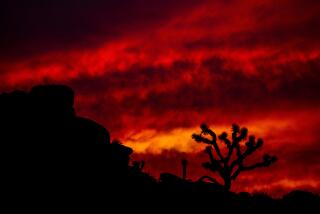Gift Trees Help to Keep Capital Tradition Alive
WASHINGTON — Every year, thousands of people come from around the world to see the famous Japanese cherry trees that adorn the nation’s capital, an event that has become as predictable as the April blossoming itself.
But the brilliant canopies of pink and white blossoms, already an elusive sight in a city where winter does not always give way to spring on time, could become even rarer--facing not only the threat of natural elements, but also the federal government’s fiscal austerity.
Today, only about 60 of the original 3,000 trees from Japan that were first planted along the banks of the Tidal Basin and nearby areas more than 70 years ago are still alive, the few survivors of disease, harsh weather and old age. The average life of the trees is less than 20 years, and even more fleeting are the delicate blossoms, which last only about a week.
Donations Sought
The National Park Service has been replacing the trees as part of a time-consuming and expensive program that has kept the number around the Tidal Basin at about 650. But the park service, reflecting government belt-tightening, has begun asking people to donate a young tree as a living gift to replace those that die each year.
The price is not exactly cheap--$150--but park service officials say the money is needed to buy a five- to six-foot-tall tree grown in a nursery for several years. Despite the cost, since it launched its “Blossoms in Our Future” project last year, the service says, more than 70 trees have been donated by residents from California to Maine.
The largest gift--a $1,500 check for 10 trees--came from Kay Sugahara, chairman of Fairfield-Maxwell, an international finance, ocean transportation and management company in New York.
‘I See the Beauty’
“I go every year to Washington and I see the beauty of the trees,” Sugahara said in an interview. “The trees won’t grow there by themselves. Everybody has to contribute a little bit to beautifying the country.”
Sugahara, an American of Japanese heritage, told the park service that he had helped to arrange a 1951 diplomatic trip to Washington by Yukio Ozaki, the mayor of Tokyo who helped to arrange the first shipment of trees in 1912.
The move to plant cherry trees around the Tidal Basin was initiated by the wife of President William H. Taft after she saw groves of the flowering trees in Japan. However, the first efforts to ship trees from Japan produced a diplomatic nightmare: The first 2,000 arrived infested with insects and disease and had to be burned.
Two years later, a second shipment, carefully propagated and fumigated, was shipped to Seattle and then transferred by insulated railroad freight cars to Washington.
More to Read
Sign up for The Wild
We’ll help you find the best places to hike, bike and run, as well as the perfect silent spots for meditation and yoga.
You may occasionally receive promotional content from the Los Angeles Times.






